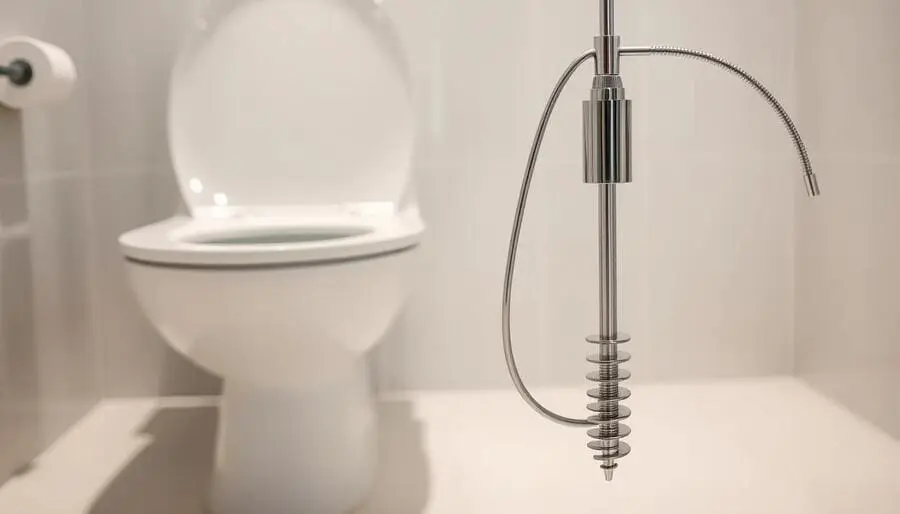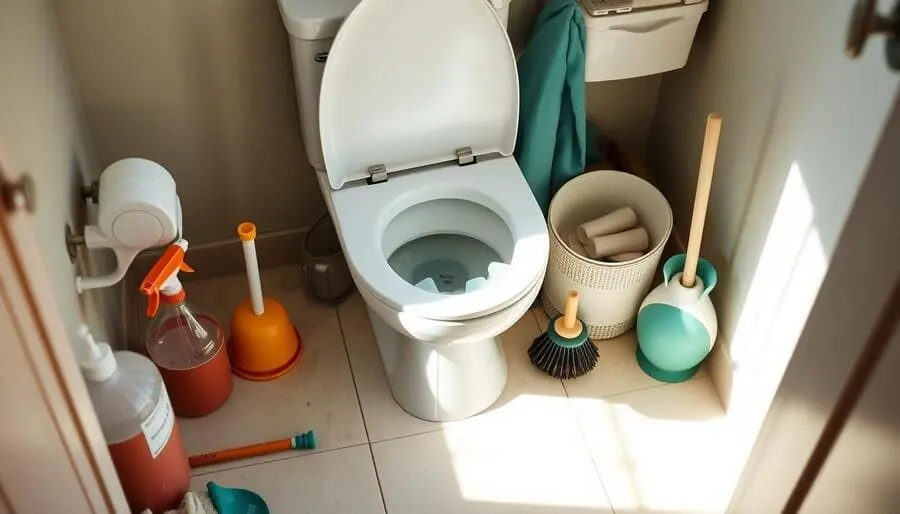Ever felt that sinking feeling when your toilet gets clogged? It’s a common problem that can cause stress, especially when you have guests coming over. But don’t worry, there are ways to fix it quickly and keep your bathroom clean.
This guide will show you six easy methods to unclog a toilet. You’ll learn how to tackle common clogs and keep your toilet in top shape. Say goodbye to the hassle of clogged toilets and hello to a clean bathroom.
Table of Contents
Understanding Common Causes of Toilet Clogs
Toilets can face many problems, but knowing why they clog is key. By avoiding toilet overload and being careful about what we flush, we can prevent blockages. This makes life easier and saves us from headaches.
One big reason for clogs is when we put too much in the toilet. Too much toilet paper or waste can overwhelm the plumbing. This can cause big problems. To fix this, flush less often and in smaller amounts.
Flushing things we shouldn’t is another big problem. Items like wipes, feminine products, and paper towels don’t dissolve in water. They can really mess up your toilet. It’s better to throw these away instead of flushing them.
1. Unclogging Toilet With a Plunger
Learning how to use a plunger is key for fixing toilet clogs. The right tool can greatly help in removing blockages.
Choosing the right type of plunger for the job
When picking a plunger, go for one made for toilets. You have two main options:
- Cup Plunger: This is a common plunger good for flat surfaces but not as effective in toilets.
- Flange Plunger: It has a floppy rubber ring under it. This plunger seals better in toilet drains and sucks up more effectively.
Step-by-step guide to unclog a toilet effectively
Here’s how to plunge effectively to clear obstructions:
- Make sure the water level is sufficient to cover the rubber cup of the plunger.
- Put the plunger over the drain hole so it fits perfectly.
- Hold the handle tight and push down hard, keeping a tight seal.
- Pull up quickly without losing the seal to get more suction.
- Do this a few times until you feel the blockage go away.
Tips for maximizing suction and avoiding splashes
To get better at plunging:
- Use quick, steady plunges instead of slow ones.
- Have a bucket ready to catch any spills and keep things clean.
- Flush the toilet after plunging to make sure the clog is gone.
2. Unclogging with a Toilet Auger
Using a toilet auger can change the game for homeowners with tough clogs. It’s great when a plunger can’t clear the clog. Knowing when to use a toilet auger helps you tackle hard blockages.
When to use a toilet auger
Knowing when to switch to a toilet auger saves time and effort. Use it in these situations:
- clogs that are too difficult to remove using a plunger.
- Blockages located deeper within the plumbing system.
- Situations where a plunger simply cannot reach the clog.
Detailed instructions on operating a toilet auger
To use a toilet auger right, follow these steps:
- Insert the toilet auger into the toilet bowl until you feel resistance.
- Crank the handle to extend the flexible auger cable into the drain.
- Crank away until the obstruction is removed.
- Once clear, retract the auger and flush the toilet to ensure proper drainage.
Knowing how to use this tool can make a big difference with tough clogs. An unclog toilet auger is key for keeping your toilet working well. It can solve problems that simpler tools can’t.

3. Using a Plastic Bottle to Unclog a Toilet
If you need to unclog a toilet without a plunger, try the unclogging toilet bottle method. It uses a plastic bottle to create pressure that can dislodge stubborn blockages.
Follow these steps for successful unclogging:
- Select a sturdy plastic bottle, preferably one with a narrow opening. A 16 to 20-ounce bottle works well for this purpose.
- Fill the bottle with hot water, leaving some room at the top to prevent spills. Avoid boiling water, as it can damage the toilet’s porcelain.
- Place the bottle’s opening directly over the toilet drain. Ensure it’s sealed to prevent air from escaping.
- Press the bottle firmly, forcing air or water into the drain. This sudden burst of pressure can help to clear the clog.
- After applying pressure, remove the bottle and check if the toilet flushes properly.
This method is great when you don’t have traditional tools. By using the unclogging toilet bottle method, you can fix many minor blockages quickly and easily.
4. Using Baking Soda and Vinegar for Natural Unclogging
Try this simple method using items you likely have at home. To unclog a toilet with baking soda and vinegar, start by getting these ingredients. This natural method is good for the environment and breaks down clogs without harsh chemicals.
Here’s how to do it right:
- First, remove as much water from the bowl as you can to avoid overflow.
- Next, pour one cup of baking soda into the bowl, making sure it covers the drain.
- Then, add one cup of vinegar, watching as it fizzes up.
- Let it sit for at least 30 minutes. This lets the baking soda and vinegar work on the clog.
- Finally, flush the toilet to get rid of any leftover debris.
This approach is great for minor clogs. It shows how you can unclog a toilet with baking soda and vinegar. Using this method regularly can help keep your plumbing in good shape and prevent future clogs.
5. How Hot Water Can Dissolve Clogs
Using hot water to unclog a toilet is a simple yet effective method. The heat can soften and dissolve clogs made of grease or soap scum. This approach helps your toilet work properly again, without harsh chemicals.
For the best results, follow these tips:
- The water should be hot but not boiling. Boiling water can harm ceramic toilets.
- Add a gallon or two of hot water. This amount usually works for most clogs.
- Pour the water from waist height. This creates pressure to help loosen the clog.
- Don’t pour water too many times in a row. This can cause overflow.
Hot water is great for clogs when other methods don’t work. The gentle heat breaks down the buildup, making it easier to flush away. Always be careful with hot water to avoid injuries.
6. Using Dish Soap
If you’re dealing with a minor clog in your toilet, dish soap can help. It acts as a lubricant, making it easier for blockages to break down and clear.
To use dish soap for unclogging toilet , pour about a cup of it into the toilet bowl. Leave to act for a few minutes. The soap will soften the clog and coat the pipes with a slippery layer.
Starting at waist height, carefully pour the hot water into the toilet bowl. This extra heat helps break down the clog and clear your toilet.
This method is great for avoiding harsh chemicals. But, if you have a persistent blockage, you might need to try to unclog a toilet with plunger or using a toilet auger.
Preventative Maintenance to Keep Toilets Clean
Keeping your toilet clean and working well needs regular effort. It’s key to set up toilet maintenance routines to stop buildup and clogs. Regular cleaning and checks help keep your toilet in top shape. They also help spot problems early, before they get worse.
To keep your toilet in great condition, make a cleaning plan. This should include:
- Daily cleaning to remove germs and Toilet bowl Stains
- Weekly deep cleaning with non-toxic products
- Monthly checks for leaks or odd noises
Sticking to these cleaning routines helps avoid clogs and keeps your bathroom clean.
Many people use chemical drain cleaners for quick fixes. But, these products can damage your pipes over time. They don’t solve problems for long and can cost a lot to fix. Instead, look for safer alternatives and natural like baking soda and vinegar work well for small clogs.
Conclusion
In this article, you’ve learned many ways to fix toilet clogs and keep your toilet working well. You saw how to use a plunger, a toilet auger, and even a plastic bottle to unclog. You also found out that baking soda, vinegar, hot water, and dish soap can help without using harsh chemicals.
Remember, keeping your toilet clean is key to avoiding clogs. A regular cleaning schedule and being careful about what you flush can help a lot. By following these tips, you can prevent annoying blockages and keep your bathroom nice.
Now, you know six effective ways to unclog a toilet. Remember, taking care of your toilet ahead of time can make it last longer and work better. With these tips, you’re ready to handle any clog that comes your way and keep your bathroom in top shape.

